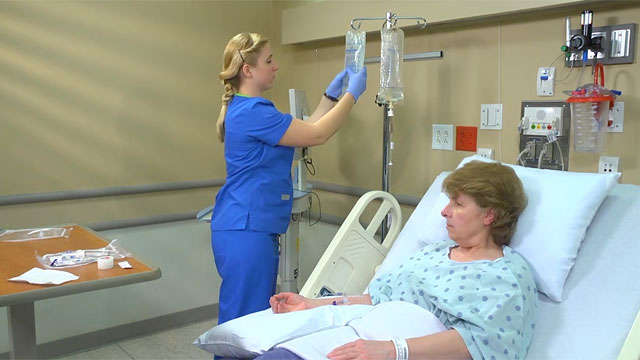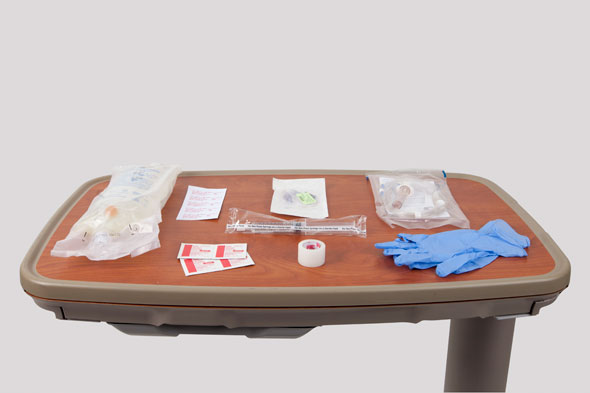Managing Intravenous Fluid Therapy
Select a Skill:
- » Regulating an Intravenous Infusion
- » Using an Infusion Pump
- » Changing Intravenous Tubing and Fluids
- » Changing Intravenous Dressings
Take the Review Test:

Safety
- Observe the Six Rights of Medication Administration.
- Change a fluid container within 24 hours of adding medication or an administration set, as recommended by the Infusion Nurses Society (INS).
- Maintain sterile technique during tubing and solution changes to prevent the entry of bacteria into the bloodstream.
- Change the tubing if it leaks, is damaged, or becomes contaminated, regardless of the tubing change schedule.
- Use Luer-Lok connections to prevent accidental disconnection.
Equipment
(Roll cursor over items to see labels)

Clean gloves
Alcohol swabs
Macrodrip administration set infusion tubing
Adapter tubing with injection cap
Tubing label
3-mL to 5-mL syring normal saline
IV fluid to be administered
Tape
Delegation
The skills of changing infusion tubing and IV solution may not be delegated to nursing assistive personnel (NAP). Delegation to licensed practical nurses (LPNs) varies according to each state’s Nurse Practice Act.
Be sure to inform NAP to report any of the following:
- If the tubing becomes disconnected or is lying on the floor
- When less than 100 mL remains in the the IV container
- Leakage from or around the IV tubing
- Cloudiness or precipitate in the IV solution
- If the alarm sounds on the electronic infusion device (EID)
- Patient complaints of pain or discomfort at the IV site
Preparation
- Confirm the accuracy and completeness of the health care provider’s orders in the medical record, checking the patient’s name and making sure that the solution type, volume, additives, flow rate, and duration of IV therapy are correct.
- Note the date and time the IV tubing and solution were last changed.
- Assess the tubing for any punctures, contamination, or occlusion that would require an immediate tubing change.
- Check the IV solution for integrity, including, but not limited to, discoloration, cloudiness, and leakage. Check the expiration date. Determine the compatibility of all IV fluids and additives by consulting an approved online database, drug reference, or the pharmacist.
- Determine if the patient understands the need for continued IV therapy.
- Assess the patency of the current venous access device (VAD) site, observing for signs and symptoms of complications, such as redness, swelling, and patient discomfort.
- Check laboratory data, such as potassium level.
Follow-up
- Evaluate the flow rate hourly, and observe the connection site for leakage.
- Observe the patient for signs of fluid volume deficit (FVD) or fluid volume excess (FVE).
- Check the entire IV system for patency, starting with the hanging solution bag and working all the way down the system to the patient’s IV access site.
- Assess the patient for signs of IV-related complications.
- Palpate the skin above the insertion site, noting its temperature and assessing for edema, tenderness, and redness.
Documentation
Record the tubing change, type of solution, volume, and rate of infusion on the patient’s MAR according to your agency’s policy. Use a special IV therapy flowsheet for parenteral fluids if required.
Review Questions
1. After changing the intravenous tubing on a patient’s primary infusion, the nurse notes air bubbles in the tubing. How would the nurse remove them?
 Begin the process again.
Begin the process again. Add more fluid to the drip chamber.
Add more fluid to the drip chamber. Inject a syringe of saline into the tubing to vent the air bubbles.
Inject a syringe of saline into the tubing to vent the air bubbles. Close the clamp, stretch the tubing downward, and flick the tubing.
Close the clamp, stretch the tubing downward, and flick the tubing.
2. Which action can the nurse take to minimize the patient’s risk for infection when applying new tubing to a primary IV infusion?
 Using aseptic technique throughout the process
Using aseptic technique throughout the process Changing the tubing each shift
Changing the tubing each shift Changing the tubing at the same time a new primary fluid bag is hung when possible
Changing the tubing at the same time a new primary fluid bag is hung when possible Both selections A and C are appropriate to minimize the patient’s risk for infection
Both selections A and C are appropriate to minimize the patient’s risk for infection
3. While changing a patient’s hospital gown, the extension set on the IV infusion becomes disconnected and ends up on the bed linens. What would the nurse do?
 Reconnect the extension set.
Reconnect the extension set. Clean the end with an alcohol swab, and reconnect it.
Clean the end with an alcohol swab, and reconnect it. Pull the IV from the site, and insert a new catheter.
Pull the IV from the site, and insert a new catheter. Change the extension set tubing.
Change the extension set tubing.
4. What would the nurse do to ensure the correct administration of gravity drip intravenous (IV) fluid after changing the tubing on a patient’s primary infusion?
 Change the tubing with each new infusion bag.
Change the tubing with each new infusion bag. Wear clean treatment gloves when changing the tubing.
Wear clean treatment gloves when changing the tubing. Recheck the drip rate by counting the drops for 1 full minute.
Recheck the drip rate by counting the drops for 1 full minute. Assess the condition of the patient’s insertion site for possible infiltration.
Assess the condition of the patient’s insertion site for possible infiltration.
5. Which instruction would the nurse give to nursing assistive personnel (NAP) when caring for a patient who is receiving IV fluids?
 “If the IV tubing gets disconnected, quickly reconnect it for me and let me know.”
“If the IV tubing gets disconnected, quickly reconnect it for me and let me know.” “It’s okay for you to turn off the pump alarm when it beeps.”
“It’s okay for you to turn off the pump alarm when it beeps.” “Let me know when the IV bag is almost empty.”
“Let me know when the IV bag is almost empty.” “Please check the IV site for me, and let me know if it’s tender.”
“Please check the IV site for me, and let me know if it’s tender.”
You have completed the Review Questions for this skill. To take the Review again select the Start Over button. To proceed to another skill select from the dropdown menu. Select the Home or Back button to proceed to the next section.


